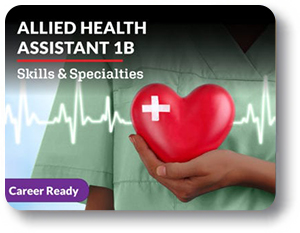
If you’re planning on going into the health care field, then this course is for you! Allied health encompasses a broad range of different health care professionals who provide a range of skills in the fields of dentistry, pharmaceutical, medicine, nursing, nutrition, rehabilitation, and more. This course is the second course of the Allied Health concentrator sequence and gives you the needed skills to pursue any of these careers in allied health.
Unit 1: Medical Lab Skills
How do allied health assistants know what type of care to provide? It might seem daunting to figure this out for each and every patient. Rest assured, however, that medical treatments and care provided are often based on diagnostic test results. Medical lab technologists (MLTs) and medical lab assistants (MLAs) play pivotal roles in making sure that safe, effective care is provided to all patients. In order to facilitate this, MLTs and MLAs are responsible for performing a wide variety of tests, maintaining equipment and lab environments, and collaborating with other health care team members. It really does take a village, but ultimately, these extra steps are well worth the effort.
What will you learn in this unit?
Unit 2: Radiology and Imaging
Radiography is a fascinating field. It is the science that creates images of the internal structure of the human body. The procedures performed by radiology technicians, X-ray machine operators, ultrasound technicians, and other health care providers aid physicians in diagnosing illnesses to ensure that patients receive the treatments needed to promote or regain their health. Get ready to learn about the various roles people play in diagnostic imaging, the equipment that is used, how the patients are positioned during procedures and how to support them during their testing.
What will you learn in this unit?
Unit 3: Cardiology: The Heart of the Matter
Without the delivery of oxygen-rich blood by the cardiovascular system, organ systems would not be able to function. Therefore, it is critical to understand how to monitor cardiovascular health so you can intervene appropriately if there are abnormalities. Having this knowledge-base is the first step in supporting an individual’s overall health. Together, we’ll explore the roles of those involved in optimizing the cardiovascular health of patients and how this is best achieved. Let’s get to the “heart” of the matter so that you don’t miss a beat in the field of cardiology!
What will you learn in this unit?
Unit 4: Respiratory Skills: Breathing Easy
The respiratory system is the site for gas exchange. Through this process, oxygen is supplied to all body systems for energy, and waste products are removed from tissues and organs. Allied Health Assistants who specialize in respiratory care work to promote respiratory health and prevent illness and complications from existing illness. By doing this, they support overall health and wellness of patients they work with. Take a deep breath and let’s explore the roles of the AHA in this important area!
What will you learn in this unit?
Unit 5: Surgical Skills
The operating room is often considered a mysterious part of health care. The preoperative and postoperative care of patients is something that people are usually familiar with, but how surgeries occur, where they are performed, and who is involved in the various types of surgical procedures remain mysterious. This is true for patients and many health care practitioners from other specialties as well. Here, we’ll provide you with foundational knowledge that will pull back the curtains and take the mystery out of the operating room!
What will you learn in this unit?
Unit 6: Pharmacy and Medication Administration
Pharmacy services involve so much more than the dispensing of medications. A great deal of coordination is required, and attention to detail is a must in this field! This branch of health science is an exciting one that will continue to expand in years to come. Gear up to learn about the different types of pharmacies and the people who work in them.
What will you learn in this unit?
Unit 7: Emergency Skills
There are so many television programs about emergency services. This makes sense because successful TV shows are exciting, suspenseful, and interesting. And while emergency services are all those things, what is not always portrayed on television is the education required to provide care to patients experiencing traumatic events, acute illnesses, or injuries. Together, we’ll explore the scope of practice of those involved in the delivery of emergency health care and learn some things that can be done to support people experiencing heath crises until trained personnel arrive.
What will you learn in this unit?
Unit 8: Dental and Veterinary Assistants
Now that we have explored allied health assistant roles for those who work with human body systems, you may also be interested in learning more about other ways you can put the skills you’ve learned to good use. Dental health, for example, is an important component of the overall wellness of an individual, and dental assistants play key roles in supporting health. Finally, we’ll examine the role of veterinary assistants—individuals who care for cherished pets, service animals, and food sources.
What will you learn in this unit?
